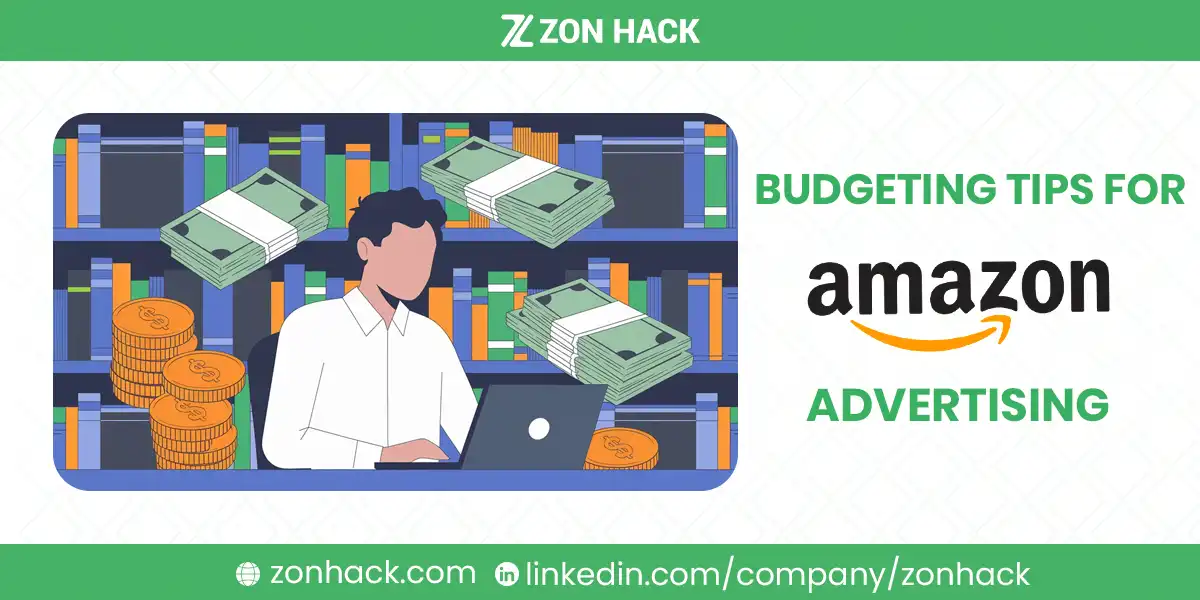Amazon Advertising has become an indispensable tool for driving sales, increasing visibility, and scaling brands. Whether you’re launching a new product, aiming to enhance brand recognition, or striving to boost sales, Amazon Advertising offers a wealth of opportunities. However, managing ad spend effectively to get the best return on investment (ROI) can be challenging.
In this article, we’ll explore actionable tips to help sellers master budgeting for Amazon Ads, maximize their ROI, and set their campaigns up for success.
The Fundamentals of Amazon Advertising
To effectively manage your budget, it’s essential to first grasp the core components of Amazon Advertising.
Amazon Advertising Ecosystem
Amazon offers a variety of ad types that cater to different advertising needs. Sponsored Products are the most common and effective, allowing sellers to advertise individual products directly on Amazon search results and product pages. These ads are known for their high click-through rates (CTR) and strong conversion potential.
Sponsored Brands ads, which feature a brand logo, a custom headline, and multiple products, are great for promoting brand awareness and driving long-term sales growth. Sponsored Display ads help you reach customers both on and off Amazon, allowing for retargeting and audience expansion, even outside of Amazon’s ecosystem.
Each of these ad types serves different purposes, and understanding their roles will be crucial when planning your budget.
Key Metrics
When budgeting for Amazon Advertising, it’s important to familiarize yourself with several key metrics that directly impact how your budget is allocated. ACoS (Advertising Cost of Sale) is one of the most important metrics to monitor. It tells you how much you’re spending on advertising relative to how much revenue you’re generating from those ads. A lower ACoS means your ads are more efficient.
Click-Through Rate (CTR) measures how often people click on your ads compared to how often they’re shown. A higher CTR generally indicates that your ads are resonating with potential customers, while a low CTR may signal that your ads or targeting need adjustments.
Additional metrics to keep an eye on include impressions, clicks, and conversions, which all contribute to assessing the overall effectiveness of your campaigns. Understanding these metrics will help you make informed decisions on where to allocate your budget for maximum impact.
Establishing Your Amazon Advertising Budget
Setting a clear and actionable budget for your Amazon Advertising campaigns requires a strategic approach. Let’s break down the steps to help you set a realistic and effective budget.
Defining Your Goals
The first step in establishing a budget for Amazon Ads is defining your advertising goals. Are you looking to increase sales, launch a new product, or build brand awareness? Each of these goals has a different impact on your budget.
- Sales growth: If driving sales is your primary goal, you’ll need to allocate a higher budget to ads that directly influence conversions, such as Sponsored Products.
- Brand awareness: For long-term visibility, consider dedicating a portion of your budget to Sponsored Brands and Sponsored Display ads, which help introduce your brand to a broader audience.
Your goals should dictate how much you’re willing to spend and how you’ll distribute your budget across different ad types.
Calculating Break-Even ACoS
To ensure your ad campaigns are profitable, you need to calculate your break-even ACoS, which represents the point at which your advertising costs are covered by the revenue generated from sales. The break-even ACoS formula is:
Break-Even ACoS=Cost of Goods Sold (COGS)Selling Price×100
For example, if the selling price of your product is $20, and your cost of goods sold is $10, your break-even ACoS would be:
Break-Even ACoS=1020×100=50%
This means that you need to keep your ACoS below 50% to ensure you’re not losing money on your ad spend. Knowing your break-even ACoS will help you allocate your budget in a way that ensures profitability.
Factoring in Average Order Value (AOV)
The Average Order Value (AOV) is another crucial metric to consider. A higher AOV gives you more room to spend on advertising without eating into your profits. For example, if your products have a higher price point, you can afford to spend more per click or conversion while still maintaining a profitable margin.
Let’s say your AOV is $50, and your break-even ACoS is 30%. If your product’s sale price is $50, your maximum allowable ad spend per order would be:
Ad Spend per Order=50×0.30=15
In this case, you can spend up to $15 on advertising per order without exceeding your desired ACoS. By factoring in AOV, you can adjust your budget more precisely based on your profit margins.
Considering Campaign Duration
The duration of your campaigns will also influence your budget decisions. Short-term campaigns, such as promotions around Black Friday or Prime Day, may require a larger budget to capitalize on high demand. On the other hand, long-term campaigns aimed at consistent brand growth may require a more gradual and steady budget allocation.
When setting your budget, be realistic about the length of the campaign. You should also consider whether the campaign will run continuously or have specific start-and-end dates that require flexibility in budget allocation.
Setting Daily Budgets
Amazon offers two options for setting daily budgets: the average daily budget and the fixed daily budget.
- Average daily budget: This allows you to set a target amount to spend each day, which Amazon can adjust based on performance. This approach offers flexibility and is great for campaigns where you expect fluctuating performance.
- Fixed daily budget: This ensures you spend the same amount every day, providing more control over your spending, especially if you’re focused on maintaining consistent costs.
Choose the option that best aligns with your campaign objectives and spend goals. While a fixed daily budget can prevent overspending, the average daily budget offers the advantage of flexibility, especially when you’re running multiple campaigns with varying results.
Allocating Your Budget Across Campaigns
Once your overall budget is established, it’s time to allocate it effectively across the different types of campaigns available on Amazon.
Sponsored Products
Given their high conversion rates and click-through performance, Sponsored Products should generally receive the largest share of your budget. Depending on your goals and the range of products you’re advertising, allocating about 70-80% of your total budget to Sponsored Product ads is a common strategy. These ads are highly targeted and can generate quick, direct sales, making them the primary driver of your Amazon advertising budget.
Sponsored Brands
While Sponsored Brands ads are excellent for brand building, they don’t typically convert as quickly as Sponsored Products. As a result, you may want to allocate about 15-20% of your total budget to these ads. Sponsored Brands help introduce your brand to a wider audience, which is especially important for long-term growth. Their visibility and ability to showcase multiple products make them invaluable in a comprehensive advertising strategy.
Sponsored Display
Although Sponsored Display ads tend to attract lower click-through rates, they’re highly effective for retargeting and reaching potential customers off Amazon. Allocating 5-10% of your budget to Sponsored Display ads is a good approach, especially if you’re looking to re-engage previous visitors or target customers outside Amazon’s core ecosystem.
Campaign Structure
Finally, organizing your campaigns based on specific factors like geographic location, product category, or marketing objective can help ensure that your budget is spent efficiently. By segmenting your campaigns, you can focus your budget on the areas that are most likely to deliver a return.
Advanced Budget Optimization Strategies
To truly maximize the efficiency of your Amazon Advertising budget, consider implementing advanced strategies.
Refining Keywords and Negative Keywords
Effective keyword management is essential for maintaining a strong ROI. Conduct thorough keyword research to find the terms your target audience is searching for. Using long-tail keywords can also be beneficial because they’re often less competitive and more specific, meaning they target buyers who are closer to making a purchase.
Negative keywords play a crucial role in keeping your ad spend efficient. By excluding irrelevant search terms, you prevent wasting money on clicks that are unlikely to convert, thereby improving your campaign’s overall performance.
Leveraging Amazon’s Automated Bidding Strategies
One of the standout features of Amazon Advertising is its automated bidding strategies. These options can help optimize your bids based on the likelihood of conversion, allowing you to focus on your broader strategy rather than constantly adjusting individual bids.
Dynamic Bidding – Down Only
Dynamic bidding with the “Down Only” option means that Amazon will automatically lower your bids when it predicts a lower likelihood of conversion. This helps ensure that your ad spend is more efficient by reducing costs in scenarios where a click may not lead to a sale. This is ideal for sellers looking to preserve their budget and avoid overspending on low-conversion opportunities.
Dynamic Bidding – Up and Down
This strategy gives Amazon the freedom to adjust your bids both upwards and downwards, depending on the predicted likelihood of a sale. If Amazon’s algorithms believe that an ad is more likely to convert, they may increase your bid to ensure maximum visibility and drive sales. However, if the chances of conversion are low, your bid will be reduced automatically. This method can be beneficial for sellers who want to capture opportunities without manual intervention, but it does require a well-defined overall strategy to maintain control over your budget.
Fixed Bidding
For those who prefer more control, the Fixed Bidding strategy allows you to set a constant bid across all auctions. While this method offers less flexibility compared to dynamic bidding, it provides a more predictable spend and can be beneficial for campaigns that require stable ad costs. Sellers who are familiar with their target audience and conversion rates might find this method more manageable.
Testing and Refining Your Amazon Ads
Even the best-laid budget plans can fall short without consistent monitoring and adjustments. Testing and optimization are ongoing processes that can have a significant impact on the performance of your campaigns.
A/B Testing (Split Testing)
Amazon offers the ability to run A/B tests, which allow you to compare different variations of your ad campaigns to determine which is most effective. You can test various elements of your ads, such as:
- Ad copy: Experiment with different headlines and product descriptions to see which resonates more with your audience.
- Images: Test variations in the visual appeal of your product images to find which ones lead to higher engagement and clicks.
- Keywords: Test different keyword strategies to understand which search terms bring in the most relevant traffic.
Through these tests, you can learn valuable insights about what works and what doesn’t, enabling you to allocate your budget more effectively based on the winning ad variations.
Refining Targeting and Audience Segmentation
As you gain more data from your campaigns, it’s important to refine your targeting to focus on the customers who are most likely to convert. Amazon offers robust targeting options, including:
- Automatic targeting: Amazon automatically selects keywords and placements based on your product information, making it easier to start advertising quickly.
- Manual targeting: You can handpick your keywords, product categories, and other targeting parameters. While this takes more time, it can lead to better results as you gain more understanding of your target market.
- Audience targeting: Amazon allows you to target users based on behaviors, interests, and past shopping history, which can be particularly useful for retargeting.
By continuously refining your targeting and audience segmentation, you can improve the efficiency of your ad spend, focusing on the users who are more likely to convert while excluding irrelevant traffic.
Monitoring Your Ad Spend and ROI
Tracking your ad performance regularly is crucial for making sure your budget is being spent wisely. Amazon provides detailed reporting tools that give insight into your ad performance, including metrics such as total ad spend, sales generated from ads, impressions, clicks, and ACoS.
Daily Performance Tracking
Keeping a close eye on your campaign’s performance on a daily basis can help identify any underperforming campaigns early. This allows you to pause or adjust campaigns that aren’t meeting your goals, reallocating your budget to higher-performing ads.
Weekly or Monthly Reporting
For a more in-depth view of your ad performance, it’s beneficial to conduct weekly or monthly reviews of your campaigns. This broader perspective allows you to see trends, patterns, and areas for improvement that might not be visible from daily monitoring alone.
Real-Time Adjustments
Amazon Ads also offer real-time performance adjustments, allowing you to pause campaigns or adjust bids when necessary. While these adjustments can be helpful, it’s essential to avoid making knee-jerk changes that could impact long-term results. Instead, monitor trends over time before implementing changes.
Scaling Your Amazon Advertising Budget
Once you’ve found a winning formula and a clear ROI, it’s time to consider scaling your Amazon Advertising efforts. However, scaling should be done thoughtfully to avoid overspending and diminishing returns.
Gradual Budget Increases
Rather than drastically increasing your ad spend all at once, consider scaling your budget incrementally. A gradual increase allows you to test the waters and ensures that you’re maintaining a healthy ACoS while maximizing your reach. For example, increasing your budget by 10-20% every couple of weeks gives you the time to assess the impact of each adjustment before committing to a larger spend.
Expand into New Campaigns or Products
As you scale, look for opportunities to expand your advertising efforts. Introducing new campaigns for Seasonal or Promotional Products can capture additional demand. You can also promote more products by creating additional Sponsored Brands campaigns that target specific product categories.
Diversifying Your Ad Types
While Sponsored Products should be your primary focus, expanding into other ad types such as Sponsored Display and Sponsored Brands as your budget allows can help you reach a broader audience. Allocating a portion of your budget to these additional ad formats can increase brand awareness, retarget past customers, and introduce your products to new segments.
Key Takeaways
Budgeting for Amazon Advertising requires a strategic approach. By understanding the core components of the platform, setting clear goals, and regularly optimizing your campaigns, you can maximize the return on your ad spend. Key practices include:
- Clearly defining your goals before allocating budget.
- Regularly monitoring key metrics like ACoS, CTR, and conversions.
- Utilizing Amazon’s automated bidding strategies for efficiency.
- Testing different ad variations to identify the most effective strategies.
- Gradually scaling your budget while avoiding common pitfalls.
By following these best practices and continuously refining your ad campaigns, you’ll be well-positioned to drive consistent growth and profitability on Amazon.




